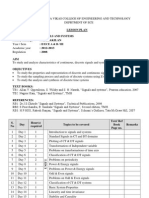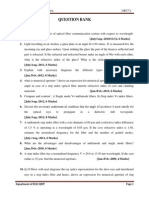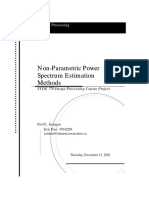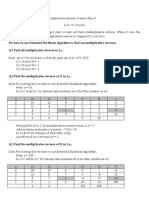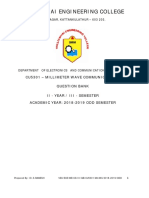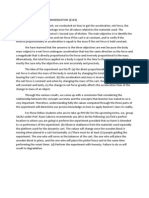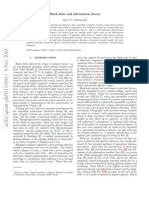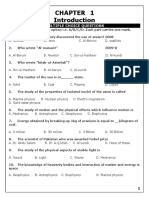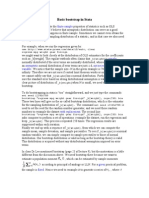Tutorial8 Solution
Uploaded by
MuhammadIdhamTutorial8 Solution
Uploaded by
MuhammadIdhamTCD2221 CRYPTOGRAPHY AND DATA SECURITY
TUTORIAL 8
NUMBER THEORY II - SOLUTIONS
(20 points)
1. a. Distinguish between a prime and a composite integer with examples.
Solution:
A positive integer is a prime if and only if it is exactly divisible by two different
integers, 1 and itself.
Example: Prime integers in the range 1 to 10: 2, 3, 5, 7
A composite is a positive integer with more than two divisors.
Example: Composite integers in the range 1 to 10: 4, 6, 8, 9, 10
b. Define the meaning of relatively prime or coprime.
Solution:
Two positive integers, a and b, are said to be relatively prime, or coprime, if
gcd (a,b) = 1.
Properties:
Number 1 is relatively prime with any integer.
If p is a prime, then all integers 1 to (p-1) are relatively prime to p.
2. Using approximation, find
(i) The number of primes between 100,000 and 200,000.
(ii) The number of composite integers between 100,000 and 200,000.
(iii) The ratio of primes to composites in the above range.
Solution:
(i) The number of primes between 100,000 and 200,000 can be found as
(200,000) (100,000).
Using the upper and lower limits devised by Gauss and Lagrange, we have
Applying the above limits,
16385 < (200,000) < 17982
(200,000) (16385+17982)/2 = 17184
8686 < (100,000) < 9588
(100,000) (8686+9588)/2= 9137
(200,000) (100,000) 17184 9137 8047
(ii) The number of composites between 100,000 and 200,000:
100001 8047 = 91954
(iii) The ratio of primes to composites in the above range:
(8047/91954)100 % or approximately 8.75%
3. Explain the sieve of Eratosthenes and explain its application.
Solution:
Application:
The Sieve of Eratosthenes is a method to find all primes less than n.
Method:
We write down all the integers between 2 and n.
We cross out all integers divisible by 2 (except 2 itself).
We cross out all integers divisible by 3 (except 3 itself).
And so on until we have crossed out all integers divisible by all primes less than n,
The remaining integers are primes.
4. a. State the use of Eulers Totient function and the rules that can be used for
finding the function.
Solution:
Use of Eulers Totient Function:
Eulers phi-function, (n), which is sometimes called the Eulers totient function,
finds the number of integers that are both smaller than n and relatively prime to n.
Rules that can be used for finding Eulers Totient Function:
b. Using the appropriate rules, find the value of
(i) (29) (ii) Z
80
*
Solution:
(i) (29) = 29-1 = 28 (since p=29 is a prime, applying 2
nd
rule)
(ii) Z
80
* = (80) = (16 5)
= (2
4
5
1
)
=(2
4
- 2
3
) (5
1
- 5
0
) (because 2 and 5 are primes-4
th
rule)
=(16-8) (5 1)
= 8 4
Z
80
* = 32
5. State the two versions of the following theorems.
(i) Fermats little theorem
(ii) Eulers theorem
Solution:
Fermats little theorem
First version:
If p is a prime and a is an integer such that p does not divide a, then
a
p 1
1 mod p
Second version:
If p is a prime and a is an integer, then
a
p
a mod p
Eulers theorem:
First version:
If a and n are coprime
a
(n)
1 (mod n)
Second version:
Removes the condition that a and n should be coprime.
If n=pq, a<n, and k an integer, then
a
k (n) + 1
a (mod n)
6. Find the results of the following using Fermats little theorem.
(i) 15
18
mod 17 (ii) 5
15
mod 13
Solution:
(i) 15
18
mod 17 = [(15
17
mod 17) (15
1
mod 17)] mod 17
= ( 15 mod 17) (15 mod 17)] mod 17
= ( 15 mod 17) (15 mod 17)] mod 17
= (15 15 ) mod 17
= 225 mod 17
15
18
mod 17 = 4
(ii) 5
15
mod 13 = [(5
2
mod 13) (5
13
mod 13)] mod 13
= ( 25 mod 13) (5 mod 13)] mod 13
= (12 5 ) mod 13
= 60 mod 13
5
15
mod 13 = 8
7. Find the results of the following using Fermats little theorem.
(i) 15
-1
mod 17 (ii) 27
-1
mod 41
Solution:
According to Fermats little theorem, if p is a prime and a is an integer such that p does not
divide a, then
a
1
mod p = a
p 2
mod p
(i) 15
-1
mod 17 =15
17-2
mod 17 =15
15
mod 17
= [(15
8
mod 17) (15
4
mod 17) (15
2
mod 17) (15
1
mod 17)] mod 17
= [(16 16) mod 17 16 mod 17 4 mod 17 15 mod 17 ] mod 17
= (1 16 4 15) mod 17
= 960 mod 17
15
-1
mod 17 = 8
(ii) 27
-1
mod 41 = 27
41-2
mod 41 =27
39
mod 41
27
39
mod 41 = 38
8. Find the results of the following using Eulers theorem.
(i) 12
-1
mod 77 (ii) 16
-1
mod 323
Solution:
If n and a are coprime, then
a
1
mod n = a
(n)1
mod n
(i) 12
-1
mod 77 = 12
(77)1
mod 77
(77) = (7 11) = (7) (11) =6 10 =60
12
(77)1
mod 77 = 12
60-1
mod 77= 12
59
mod 77
= (12
1
mod 7712
2
mod 7712
8
mod 7712
16
mod 7712
32
mod 77) mod 77
= (1267672367) mod 77 = 45
12
-1
mod 77 = 45
(Note: We can also use square and multiply method of fast exponentiation algorithm to
find 12
59
mod 77 = 45)
(ii) 16
-1
mod 323 = 16
(323)1
mod 323
(323) = (17 19) = (17) (19) =16 18 =288
16
(323)1
mod 323 = 16
288-1
mod 323= 16
287
mod 323
= (16
1
mod 32316
2
mod 32316
4
mod 32316
8
mod 32316
16
mod 32316
256
mod
323) mod 323
= (16256290120188290) mod 323
= 101
16
-1
mod 323= 101
(Note: We can also use square and multiply method of fast exponentiation algorithm to
find 16
287
mod 323 = 101)
9. Find the value of x using the chinese remainder theorem.
x 2 mod 7, and x 3 mod 9
Solution:
Given:
x 2 mod 7, and x 3 mod 9
Hence m
1
= 7,
m
2
= 9,
a
1
= 2,
a
2
= 3
1. Find M =m
1
m
2
. This is the common modulus.
M = 79=63
2. Find M
1
=M/m
1
, M
2
=M/m
2
M
1
= 63/7 = 9
M
2
= 63/9 = 7
3. Find the multiplicative inverse of M
1
and M
2
using the corresponding moduli (m
1
,m
2)
Call the inverses M
1
1
, and M
2
1
.
M
1
1
=9
-1
mod 7
=9
7-2
mod 7
( a
1
mod p = a
p 2
mod p if p is a prime and a is an integer such that p does not divide a
Fermats little theorem)
=9
5
mod 7
= (9
2
9
2
9
1
) mod 7
=[(81 mod 7) (81 mod 7) (9 mod 7)] mod 7
= ( 4 4 2 ) mod 7
= 32 mod 7
M
1
1
= 4
M
2
1
=7
-1
mod 9
=7
(9)1
mod 9
(a
1
mod n = a
(n)1
mod n if n and a are coprime Eulers theorem)
(9)= (3
2
) = 3
2
- 3
2-1
= 3
2
- 3
1
= 9
- 3 =6 )
=7
61
mod 9
=7
5
mod 9
= (7
2
7
2
7
1
) mod 9
=[(49 mod 9) (49 mod 9) (7 mod 9)] mod 9
= ( 4 4 7 ) mod 9 = 112 mod 9
M
2
1
= 4
4. The solution to the simultaneous equations is
x =(2 9 4 +3 7 4) mod 63 =156 mod 63 =30
Answer: x=30
This value satisfies the given two equations:
30 2 (mod 7), 30 3 (mod 9)
10. Find the results of the following using the square-and-multiply method of fast
exponentiation algorithm.
(i) 21
24
mod 8 (ii) 2001
35
mod 2000
Solution:
(
ii) 2001
35
mod 2000
Given: a=2001, x=35=100011, n=2000
i x
i
Multiplication (Initialization: y=1) Squaring (Initialization: a=2001)
0 1 y=(2001*1)mod2000=1 a=(2001)
2
mod 2000 =1
1 1 y=(1*1)mod2000=1 a=(1)
2
mod 2000 =1
2 0 ------------------------ a=(1)
2
mod 2000 =1
3 0 ------------------------ a=(1)
2
mod 2000 =1
4 0 ------------------------ a=(1)
2
mod 2000 =1
5 1 y=(1*1)mod2000=1 ------------------------
Result: 2001
35
mod 2000=1
References:
1. Behrouz A. Forouzan, "Cryptography and Network Security",1
st
Edition,
McGraw-Hill, 2008
2. William Stallings, Cryptography and Network Security Principles and Practices,
4/E, Prentice Hall, 2006.
You might also like
- Instant Ebooks Textbook (Ebook PDF) Foundations of Astronomy 14th Edition by Michael A. Seeds Download All Chapters100% (4)Instant Ebooks Textbook (Ebook PDF) Foundations of Astronomy 14th Edition by Michael A. Seeds Download All Chapters51 pages
- 5CS3-01: Information Theory & Coding: Unit-4 Cyclic CodeNo ratings yet5CS3-01: Information Theory & Coding: Unit-4 Cyclic Code67 pages
- AIM: To Design of LPC Filter Using Levinson-Durbin AlgorithmNo ratings yetAIM: To Design of LPC Filter Using Levinson-Durbin Algorithm3 pages
- Question Bank - Telecommunication Switching Systems (404187)No ratings yetQuestion Bank - Telecommunication Switching Systems (404187)31 pages
- Addis Ababa University: (DLD-Assignment 1)No ratings yetAddis Ababa University: (DLD-Assignment 1)7 pages
- ECE3073 Computer Systems Practice Questions Bus InterfacingNo ratings yetECE3073 Computer Systems Practice Questions Bus Interfacing2 pages
- EC 2301 Digital Communication Unit I and II Question BankNo ratings yetEC 2301 Digital Communication Unit I and II Question Bank63 pages
- Performance Analysis of Higher Order ModulationNo ratings yetPerformance Analysis of Higher Order Modulation30 pages
- FON Lavanya Notes-Module-3-Optical Sources100% (1)FON Lavanya Notes-Module-3-Optical Sources19 pages
- Solution 2013 Final Exam (1) : Q.1 (A) The Number of Modes in An Optical Fiber, Having Core and CladdingNo ratings yetSolution 2013 Final Exam (1) : Q.1 (A) The Number of Modes in An Optical Fiber, Having Core and Cladding7 pages
- Ece-V-Information Theory & Coding (10ec55) - AssignmentNo ratings yetEce-V-Information Theory & Coding (10ec55) - Assignment10 pages
- Exercise Problems: Information Theory and CodingNo ratings yetExercise Problems: Information Theory and Coding6 pages
- Chapter 7 - Poisson's and Laplace EquationsNo ratings yetChapter 7 - Poisson's and Laplace Equations19 pages
- Digital Signal Processing Two Mark Question With Answer Unit III100% (1)Digital Signal Processing Two Mark Question With Answer Unit III4 pages
- EC 6702-2 Marks QP With Answer, 16 MarkNo ratings yetEC 6702-2 Marks QP With Answer, 16 Mark19 pages
- Cs8351-Digital Principles and System Design-1007732531-Dpsd Quest BankNo ratings yetCs8351-Digital Principles and System Design-1007732531-Dpsd Quest Bank14 pages
- Digital Signal Processing R13 Previous Papers100% (1)Digital Signal Processing R13 Previous Papers5 pages
- Lecture 2 Fundamental Steps in Digital Image ProcessingNo ratings yetLecture 2 Fundamental Steps in Digital Image Processing4 pages
- Ece Vii Optical Fiber Communication 10ec72 Question PaperNo ratings yetEce Vii Optical Fiber Communication 10ec72 Question Paper10 pages
- Non-Parametric Power Spectrum Estimation Methods100% (1)Non-Parametric Power Spectrum Estimation Methods25 pages
- Ec8501-Digital Communication-1142519233-1564326036555 - Ec 8501 DC QBNo ratings yetEc8501-Digital Communication-1142519233-1564326036555 - Ec 8501 DC QB28 pages
- Digital Signal Processing Question Bank PDFNo ratings yetDigital Signal Processing Question Bank PDF15 pages
- Seminar Presentation On Optical Packet Switching.: Bachelor of Engineering in Electronic and Communication EngineeringNo ratings yetSeminar Presentation On Optical Packet Switching.: Bachelor of Engineering in Electronic and Communication Engineering25 pages
- Optical Communication Past Questions and SolutionsNo ratings yetOptical Communication Past Questions and Solutions25 pages
- Ece-Vii-dsp Algorithms & Architecture (10ec751) - Question PaperNo ratings yetEce-Vii-dsp Algorithms & Architecture (10ec751) - Question Paper9 pages
- Sequential Circuits: Digital ElectronicsNo ratings yetSequential Circuits: Digital Electronics10 pages
- Information Theory and Coding SEE QP 2021-22No ratings yetInformation Theory and Coding SEE QP 2021-227 pages
- Atmospheric Data Collection, Processing and Database Management in India Meteorological Department PDFNo ratings yetAtmospheric Data Collection, Processing and Database Management in India Meteorological Department PDF9 pages
- 10+2 Level Mathematics For All Exams GMAT, GRE, CAT, SAT, ACT, IIT JEE, WBJEE, ISI, CMI, RMO, INMO, KVPY Etc.From Everand10+2 Level Mathematics For All Exams GMAT, GRE, CAT, SAT, ACT, IIT JEE, WBJEE, ISI, CMI, RMO, INMO, KVPY Etc.No ratings yet
- Hermann Chroust (1965) - Aristotle and The 'Philosophies of The East'No ratings yetHermann Chroust (1965) - Aristotle and The 'Philosophies of The East'10 pages
- Creación ex nihilo_ teología y ciencia _ Fe razonableNo ratings yetCreación ex nihilo_ teología y ciencia _ Fe razonable19 pages
- Cosmic Rhythms - Session 1 - IntroductionNo ratings yetCosmic Rhythms - Session 1 - Introduction25 pages
- Supplementary Notes on Countability by PriestleyNo ratings yetSupplementary Notes on Countability by Priestley3 pages
- Black Holes and Information Theory - by Jacob D. Bekenstein100% (2)Black Holes and Information Theory - by Jacob D. Bekenstein12 pages
- Rorty, Richard - Pragmatism, Categories, and Language (1961)No ratings yetRorty, Richard - Pragmatism, Categories, and Language (1961)28 pages
- B SC Physics Syllabus - Davangere University (2014-15) RevisedNo ratings yetB SC Physics Syllabus - Davangere University (2014-15) Revised10 pages
- A Monte Carlo Modeling of Planetary Formation: A Case of 47 Ursae Majoris SystemNo ratings yetA Monte Carlo Modeling of Planetary Formation: A Case of 47 Ursae Majoris System7 pages
- Dane Rudhyar - The Planets and Their Symbols100% (1)Dane Rudhyar - The Planets and Their Symbols13 pages
- Instant Ebooks Textbook (Ebook PDF) Foundations of Astronomy 14th Edition by Michael A. Seeds Download All ChaptersInstant Ebooks Textbook (Ebook PDF) Foundations of Astronomy 14th Edition by Michael A. Seeds Download All Chapters
- 5CS3-01: Information Theory & Coding: Unit-4 Cyclic Code5CS3-01: Information Theory & Coding: Unit-4 Cyclic Code
- AIM: To Design of LPC Filter Using Levinson-Durbin AlgorithmAIM: To Design of LPC Filter Using Levinson-Durbin Algorithm
- Question Bank - Telecommunication Switching Systems (404187)Question Bank - Telecommunication Switching Systems (404187)
- ECE3073 Computer Systems Practice Questions Bus InterfacingECE3073 Computer Systems Practice Questions Bus Interfacing
- EC 2301 Digital Communication Unit I and II Question BankEC 2301 Digital Communication Unit I and II Question Bank
- Solution 2013 Final Exam (1) : Q.1 (A) The Number of Modes in An Optical Fiber, Having Core and CladdingSolution 2013 Final Exam (1) : Q.1 (A) The Number of Modes in An Optical Fiber, Having Core and Cladding
- Ece-V-Information Theory & Coding (10ec55) - AssignmentEce-V-Information Theory & Coding (10ec55) - Assignment
- Digital Signal Processing Two Mark Question With Answer Unit IIIDigital Signal Processing Two Mark Question With Answer Unit III
- Cs8351-Digital Principles and System Design-1007732531-Dpsd Quest BankCs8351-Digital Principles and System Design-1007732531-Dpsd Quest Bank
- Lecture 2 Fundamental Steps in Digital Image ProcessingLecture 2 Fundamental Steps in Digital Image Processing
- Ece Vii Optical Fiber Communication 10ec72 Question PaperEce Vii Optical Fiber Communication 10ec72 Question Paper
- Ec8501-Digital Communication-1142519233-1564326036555 - Ec 8501 DC QBEc8501-Digital Communication-1142519233-1564326036555 - Ec 8501 DC QB
- Seminar Presentation On Optical Packet Switching.: Bachelor of Engineering in Electronic and Communication EngineeringSeminar Presentation On Optical Packet Switching.: Bachelor of Engineering in Electronic and Communication Engineering
- Optical Communication Past Questions and SolutionsOptical Communication Past Questions and Solutions
- Ece-Vii-dsp Algorithms & Architecture (10ec751) - Question PaperEce-Vii-dsp Algorithms & Architecture (10ec751) - Question Paper
- Atmospheric Data Collection, Processing and Database Management in India Meteorological Department PDFAtmospheric Data Collection, Processing and Database Management in India Meteorological Department PDF
- 10+2 Level Mathematics For All Exams GMAT, GRE, CAT, SAT, ACT, IIT JEE, WBJEE, ISI, CMI, RMO, INMO, KVPY Etc.From Everand10+2 Level Mathematics For All Exams GMAT, GRE, CAT, SAT, ACT, IIT JEE, WBJEE, ISI, CMI, RMO, INMO, KVPY Etc.
- Hermann Chroust (1965) - Aristotle and The 'Philosophies of The East'Hermann Chroust (1965) - Aristotle and The 'Philosophies of The East'
- Creación ex nihilo_ teología y ciencia _ Fe razonableCreación ex nihilo_ teología y ciencia _ Fe razonable
- Black Holes and Information Theory - by Jacob D. BekensteinBlack Holes and Information Theory - by Jacob D. Bekenstein
- Rorty, Richard - Pragmatism, Categories, and Language (1961)Rorty, Richard - Pragmatism, Categories, and Language (1961)
- B SC Physics Syllabus - Davangere University (2014-15) RevisedB SC Physics Syllabus - Davangere University (2014-15) Revised
- A Monte Carlo Modeling of Planetary Formation: A Case of 47 Ursae Majoris SystemA Monte Carlo Modeling of Planetary Formation: A Case of 47 Ursae Majoris System

















